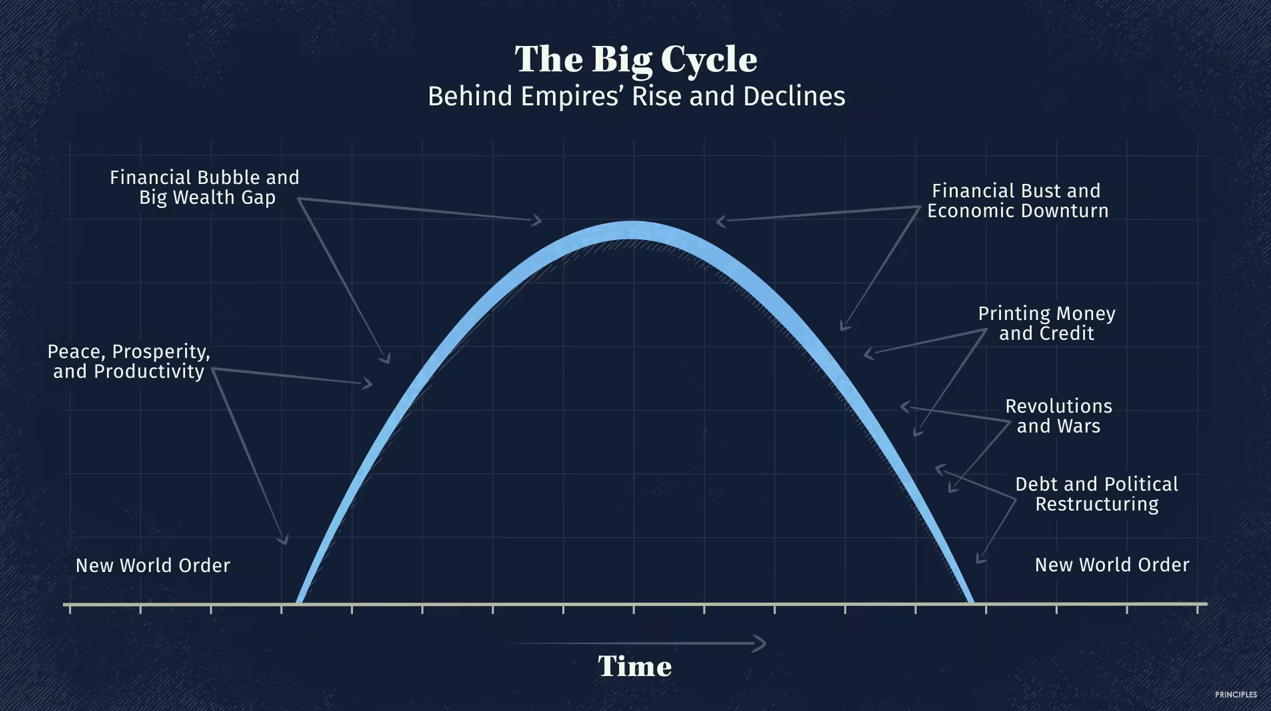The Changing World Order

Ray Dalio's The Changing World Order offers a comprehensive analysis of historical cycles in economic, political, and societal systems, with a focus on understanding how they shape global power dynamics.

1. The Big Cycles
Dalio identifies recurring patterns in history, which he calls "big cycles." These include:
- Economic Cycles: Driven by debt accumulation and deleveraging.
- Political Cycles: Shaped by rising and declining empires.
- Social Cycles: Influenced by wealth gaps, conflicts, and revolutions.
He emphasizes that these cycles unfold predictably and interact to shape the world order.
2. The Rise and Fall of Nations
Dalio outlines the stages of an empire's life cycle:
- Emergence: Strong leadership, innovation, and education fuel growth.
- Peak: A period of prosperity, dominance, and cultural influence.
- Decline: Accumulated debt, internal conflict, and external competition lead to stagnation and loss of power.
He analyzes historical examples, such as the Dutch, British, and American empires, showing how their trajectories align with these stages.
3. The Role of Debt and Money
Debt plays a central role in the rise and fall of nations:
- Excessive borrowing eventually leads to crises and economic restructuring.
- The ability to control the world's reserve currency (e.g., the U.S. dollar) provides temporary advantages but is not sustainable indefinitely.
4. Wealth and Power Shifts
Dalio highlights the impact of economic and technological advancements in redistributing global power. For instance:
- The rise of China as a major global player mirrors earlier cycles of ascending empires.
- The U.S., while still powerful, shows signs of decline, including growing debt, political polarization, and wealth inequality.
5. Principles for Navigating Change
Dalio offers practical principles for individuals, businesses, and governments to navigate these shifts:
- Study history to recognize patterns.
- Diversify investments to reduce risk.
- Embrace adaptability and innovation in times of change.
6. China and the Emerging World Order
Dalio devotes significant attention to China's rise, comparing it to past empires at their peaks. He explores its economic policies, cultural factors, and geopolitical strategies, arguing that its growth could reshape the global balance of power.
7. Warnings and Opportunities
Dalio emphasizes that the transitions between world orders are often marked by:
- Economic crises (e.g., inflation, currency devaluation).
- Social unrest (e.g., wealth inequality and political instability).
- Geopolitical conflicts (e.g., wars or rivalries for dominance).
However, he also points out opportunities for renewal, innovation, and cooperation if these challenges are managed wisely.
Core Takeaway:
History follows cyclical patterns that provide valuable lessons for understanding the present and preparing for the future. By studying the rise and fall of empires, nations, and economies, individuals and leaders can make better decisions in a rapidly changing world.
